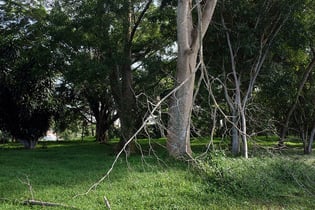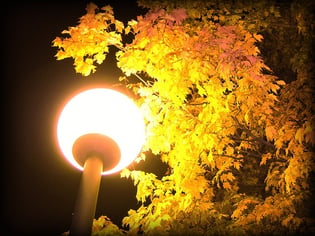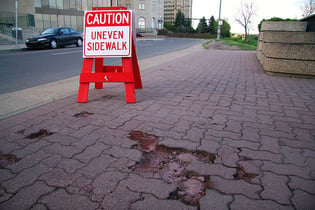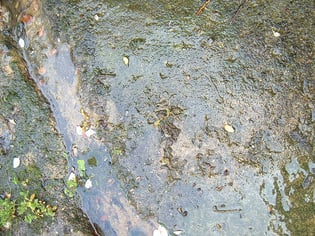Lush lawns, fragrant flower beds, elegant shade trees. A well-maintained landscape is one of the most relaxing sights on the planet. But if you’re the property owner, don’t let your guard down. That beautiful scene hides many potential hazards.
Landscape-related pedestrian injuries are more common than most people realize. Besides the pain and inconvenience they cause, such injuries can — and often do — result in costly lawsuits.
It’s not uncommon for litigation costs to exceed the cost of a landscape installation!
Pedestrian Safety Tips for Commercial Landscapes
Fortunately, most injuries that could happen on your property are preventable. Let’s take a look at some of the most common areas where you can improve pedestrian safety on a commercial property.
Trees
 Older trees should be inspected regularly for weak or dead branches which could fall and cause injury to people or damage to buildings. Young trees should be properly pruned to prevent improper growth habits. Tree roots, too, can cause problems. People can trip directly on the roots themselves or on disturbed pavement that tree roots have caused to heave.
Older trees should be inspected regularly for weak or dead branches which could fall and cause injury to people or damage to buildings. Young trees should be properly pruned to prevent improper growth habits. Tree roots, too, can cause problems. People can trip directly on the roots themselves or on disturbed pavement that tree roots have caused to heave.
Shrubs And Flower Beds
Many of our bank clients have mandates about shrubbery — and for good reason. Improperly placed, overgrown shrubs can easily conceal a lurking assailant. Trimming the shrubbery and landscape plants around ATMs, as well as libraries, college campuses, and other institutions, can help prevent robberies, rapes and similar crimes. Homeowners, too, should think about this when they plan their landscaping.
Lighting
One huge safety problem we’ve observed is poor visibility in the landscape. It’s not uncommon for an electrician to install a light on a sign without thinking about placing it so that it will not create glare that can blind passersby.
 The same is true for the placement of lampposts and parking lot lights. It’s important to choose and place lighting that puts light where you need it — typically on the ground — rather than into the eyes of pedestrians and motorists where it may lead to serious traffic accidents or falls.
The same is true for the placement of lampposts and parking lot lights. It’s important to choose and place lighting that puts light where you need it — typically on the ground — rather than into the eyes of pedestrians and motorists where it may lead to serious traffic accidents or falls.
Thought should also be given to who the users are. For example, an elderly person needs considerably more light than a 20 year old, so it follows that the lighting around a senior facility will need to be brighter and more densely placed than on a college campus.
Irrigation
Some of the worst landscape related injuries occur on athletic fields, playgrounds, parks, and other public areas where the irrigation system has not been carefully maintained. The number one issue is when the heads are not properly set and packed. They can easily get too deep or leave a pothole. It often happens that when the turf is managed well, it will grow aggressively over the hole, making it invisible to passersby. Falls that result from stepping into the hole unawares can result in broken bones, sprains and other serious injury.
To prevent injury and litigation, irrigation systems need to be inspected on a regular basis. Savvy companies have apps that allow them to check and keep track of the inventory. A proactive property manager can use remote management technology to know from his desk when improper flow conditions occur, which can indicate a problem. We have set up many such systems for our commercial customers with great results.
Hardscape
 The design and construction of hardscape elements such as stairs, landings, and ramps is critical to pedestrian safety. Steps especially have to be properly proportioned. Any variation between the riser and tread in the step sequence can create a definite trip hazard.
The design and construction of hardscape elements such as stairs, landings, and ramps is critical to pedestrian safety. Steps especially have to be properly proportioned. Any variation between the riser and tread in the step sequence can create a definite trip hazard.
Poorly installed hardscapes are also prone to cracking, crumbling and buckling, which can also lead to trips and falls.
Drainage
Improper drainage can cause all sorts of safety issues. Flooding can be dangerous in itself but also leads to trip hazards due to erosion. Many pedestrians have been injured after stormwater washed the soil out from the edge of a sidewalk. Water can even undermine pavement in some cases.
Slip hazards occur not only with winter ice but where deposition of sediment causes slippery algae growth. Even where it is not overtly dangerous, poor drainage can be quite inconvenient and reflect badly on your business. Who wants to step into three inches of water in your parking lot?
Want To Improve Pedestrian Safety? Stay Away From Shortcuts
 One of the biggest safety hazards we’ve observed in the landscape industry is the “shortcut attitude.” Compromising project quality in an attempt to cut costs or save time often results in hazardous conditions. One common example is laying pavers over a bit of sand and excavated earth.
One of the biggest safety hazards we’ve observed in the landscape industry is the “shortcut attitude.” Compromising project quality in an attempt to cut costs or save time often results in hazardous conditions. One common example is laying pavers over a bit of sand and excavated earth.
Doing it this way may be ok for a walkway but it won’t hold up when trucks are driven on it — which happens more often than you would think, even on sidewalks. When we take the time to be sure the base is well compacted it makes a huge difference in how the pavement will perform over time.
Do you have concerns about how your landscaping will impact pedestrian safety on your commercial property? Contact us online, or give us a call at 478-750-7733 to speak with one of our qualified landscape professionals.
We find that approaching every aspect of landscape installation and maintenance by doing things right the first time makes a tremendous difference in the level of safety on a property and saves you money in the long run.
Images: Shoes, Broken branch, Campus lighting, Slippery sidewalk, Broken sidewalk
1 Oct 2024


